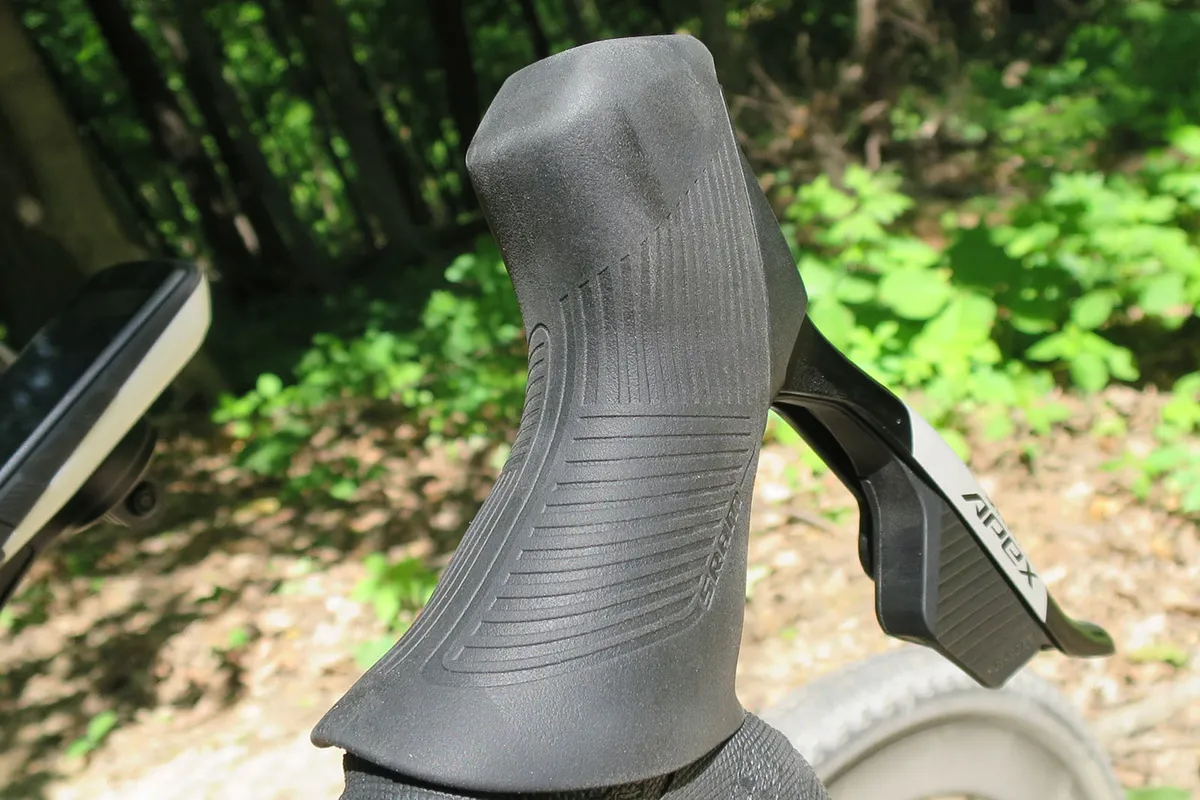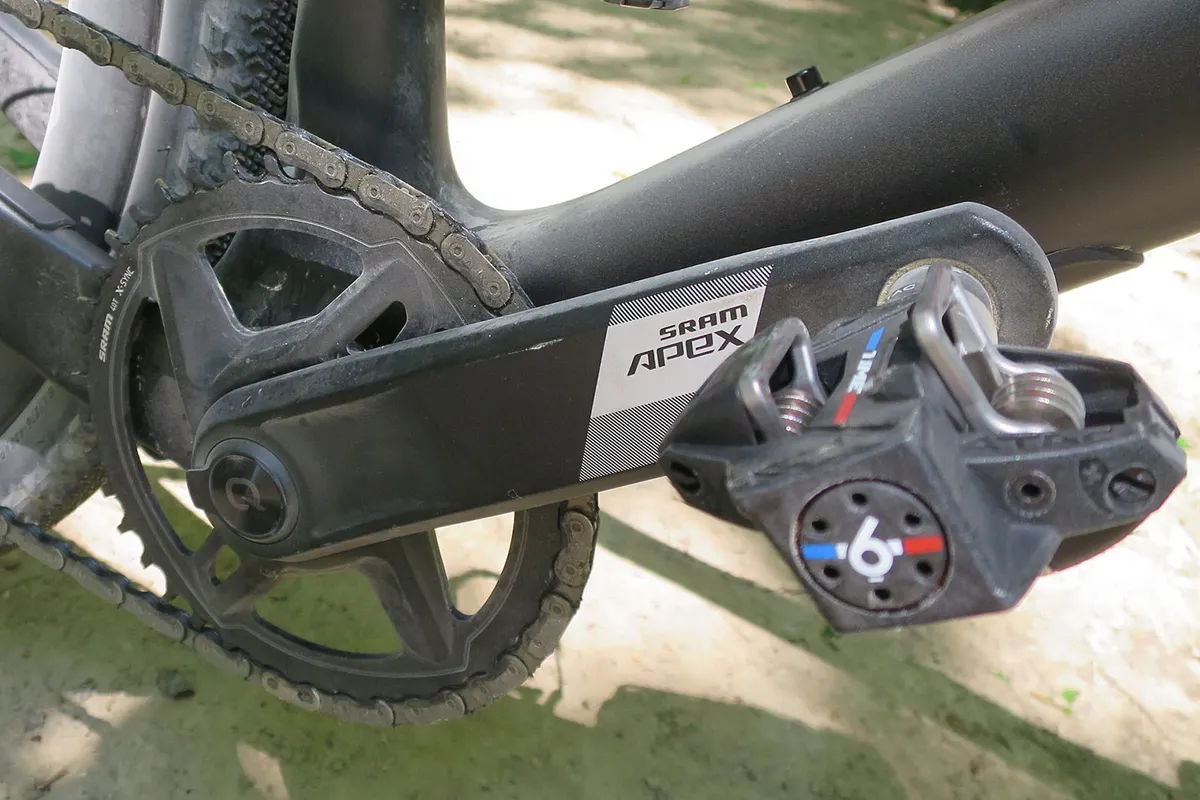SRAM has expanded its AXS electronic shifting down to the fourth-tier Apex level.
Underpinning its Rival, Force and Red groupsets, the new Apex AXS aims to bring the full advantages of electronic shifting to a new price-conscious rider.
I took the opportunity to visit the Driftless region on the western border of Illinois, USA for a first ride with the new gravel groupset.
My test riding covered more than 75km over two days – enough to form an early impression of the groupset as a whole.
SRAM Apex AXS XPLR first impressions

My test setup was an Apex AXS XPLR groupset complete with the optional-upgrade power meter, an 11-44 tooth cassette matched to a 40-tooth chainring.
On its own, this should retail for £1,467/$1,415/€1,641.
It was fitted to a Cervélo Aspero, and my first impression is how similar the new groupset looks here to the Rival AXS XPLR drivetrain that came fitted to the Aspero I tested in 2022.

With just 50g (claimed) between the two groupsets, there’s not going to be a huge difference in complete bike weights.
That said, it can be assumed that an Apex AXS-equipped bike would come with cheaper (usually heavier) finishing kit to meet the $2,500 to $4,000 price range SRAM expects it to command.
For each ride, the system connected quickly and easily to both my Hammerhead Karoo 2 head unit and the AXS app on my iPhone.
You have access to SRAM’s full suite of data recording, which is among the most comprehensive in the business.
SRAM Apex AXS levers and shifters

But for a good example of how familiar the whole group looks and feels, the shifters are a great place to start.
They’re the same shifters as Rival AXS (apart from being made of pressed alloy, rather than forged), which in turn have the same profile as the latest Force AXS lever.
In the hand, they feel much the same – the broad profile of the lever is a big improvement over the old-shape eTap levers, with a better feel and improved interaction from the hoods.
You can alter the reach via a 2.5mm hex bolt on the hood, just like Rival AXS, and the scalloped shape of the triggers is easy to locate when bouncing across rough ground.

Internally, the shifters use the same electronics as higher-tier SRAM groupsets and run with the same CR2032 cells in each hood.
Additionally, my test bike was equipped with SRAM’s wireless Blips mounted on the underside of the bar tops.
I love the functionality of the Blips, though I’m still not 100 per cent convinced a disposable design is the best way to go.
SRAM claims they will last a ‘normal usage’ rider for nearly 10 years. However, in high-usage applications such as time trials or triathlon, that would drop to around four years.
SRAM Apex AXS brake calipers

The brake calipers follow the same design as the latest Force AXS brakes, with re-profiled internals and a new two-piece body.
The brake performance and feel are very familiar, but what was most noticeable was the lack of any rotor scrape. Even after many hours in the saddle in hot, dry and dusty conditions, the wheels spun smoothly, and the braking remained quiet throughout.
For Apex, SRAM has forgone its Bleeding Edge ports, instead using threaded bleed ports (which means brake maintenance will take a little longer).
SRAM Apex AXS chainset

The crankset is practically a carry-over from Rival AXS too – alloy crank arms attached to a DUB axle with a direct-mount chainring.
The matt finish with laser-etched logos may not look as premium as the high gloss of Rival, but under its understated skin, it’s the same unit.
The crank arms are forged, but are hollowed out on their inside face to reduce weight.
It could be considered less technical, and cheaper in appearance, than fully hollow crank arms, but the end result is much the same.

The crank arms felt stiff enough, as did the chainring (made in a similar hollowed-out method).
The machined teeth in SRAM’s ‘narrow-wide’ pattern meant there wasn’t a suggestion of dropping a chain, even when I took the bike on some more challenging mountain bike trails.
The included power meter records only the left-leg power and calculates totals (just like Rival AXS), but at first glance it seems consistent with the years of data I’ve got from the double-sided Force and Red power meters I have on my personal bikes.
SRAM Apex AXS XPLR rear derailleur, cassette and chain

The Apex AXS XPLR derailleur’s compact body is another direct port over from Rival AXS.
The longer XPLR cage added brings a capacity of up to 44 teeth for the rear cassette (you can run a 52t cassette with a switch to the Eagle version).
The derailleur shifted smoothly and efficiently up and down the rear block, and the spring-loaded clutch does a superb job of keeping chain bounce in check. I got no hint of slap even when riding rutted root-strewn sections of singletrack.

On pure gravel roads, the Apex rear derailleur was completely unfazed.
The shift quality across the 11-44t cassette felt consistent, and chain buzz (where the chain can contact neighbouring sprockets at the extreme ends of the cassette) was kept to a minimum.
SRAM’s flat-topped chain design continues down to Apex level, but unlike the polished and plated versions higher up the range, Apex has an understated grey finish.
To my eye, it means even a new chain looks somewhat used, even when clean.
SRAM Apex AXS XPLR early verdict

Overall, the most impressive thing about Apex AXS is just how close it feels in shifting, braking and total usability to its more expensive stablemates.
There is no difference in shift speed, chain control and braking feel that I can decipher between Apex and Rival, for example.
To its credit, SRAM has considered that riders at the more price-conscious end of the market are just as likely to want to ride and train with power. Even the power meter isn’t compromised compared to the Rival or 1x-specific Force option.

The only real differences across the groupset are in material choices and finish, which has a small bearing on the overall weight.
Many shouldn’t be overly concerned with weight (especially when it comes to gravel riding), but the real proof with Apex AXS will be its longevity.
On the face of it, where scuffs and knocks are par for the course, the legitimate question is: why pay more?
As ridden prices and weights
Weights (claimed)
- Control ED/SD + brake (r): 420g
- Control ED/SD + brake (l): 405g
- Crank with power meter: 743g
- Derailleur: 327g
- Cassette (11-44) PG-1231: 425g
- Chain (120 links) APEX D1: 260g
- Bottom bracket: 76g
- Rotors: 2x Paceline rotors (160mm): 336g
- Battery: 24g
- Total: 3,016g
Prices
- Control ED/SD + brake (r): £235/$220/€265
- Control ED/SD + brake (l): £235/$220/€265
- Crank with power meter: £120/$110/€130 + £205/$220/€230
- Derailleur: £295/$275/€330
- Cassette (11-44) PG-1231: £135/$124/€150
- Chain (120 links) APEX D1: £32/$30/€36
- Bottom bracket: £36/$43/€42
- Rotors: 2x Paceline rotors (160mm): £54/$54/€60
- Battery: £56/$59/€63
- Total: £1,457/$1,409/€1,631
Product
| Brand | Sram |
| Price | €1631.00, £1457.00, $1409.00 |
| Weight | 3016g |
